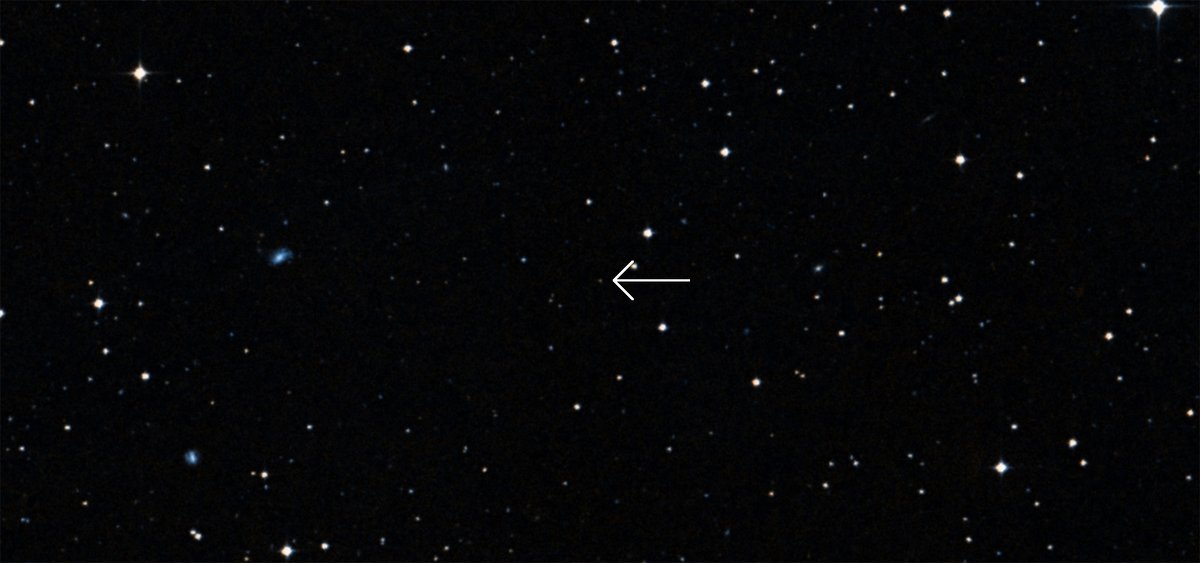In the *very* distant Universe, astronomers have found a black hole that is so huge, so bright, and so gluttonous that my brain wants to leap out my skull and run around screaming. https://www.syfy.com/syfywire/supermassive-black-hole-eats-a-sun-a-day
2/ I’m afraid I can’t overstate the superlatives about this thing. First, the distance: The black hole is in the heart of a quasar over 12.5 BILLION light years away.
We see it as it was only about 1.25 billion years after the Universe itself was born!
We see it as it was only about 1.25 billion years after the Universe itself was born!
3/ Here’s an image of the quasar. It’s literally the most luminous galaxy ever seen, but so far away it’s a barely visible dot in this shot.
How luminous? It blasts out the equivalent of ONE QUADRILLION times the Sun’s energy. That’s roughly 1000x our entire galaxy’s output.
How luminous? It blasts out the equivalent of ONE QUADRILLION times the Sun’s energy. That’s roughly 1000x our entire galaxy’s output.
4/ The black hole powering all this is a monster. Just unbelievably huge.
The astronomers measured the black hole’s mass to be
34 BILLION TIMES THE SUN’S MASS.
Most *galaxies* don’t have that kind of heft.
The astronomers measured the black hole’s mass to be
34 BILLION TIMES THE SUN’S MASS.
Most *galaxies* don’t have that kind of heft.
5/ Mind you, there are more massive black holes that have been found, but they’re much closer to us. This is the most massive one found at such an early epoch in the Universe.
We’re still not sure how they get so big so quickly. But they have to eat a LOT, and FAST.
We’re still not sure how they get so big so quickly. But they have to eat a LOT, and FAST.
6/ This part is incredible. Matter falling into the black hole heats up and emits light, and the more massive the black hole the more light it emits. Knowing how bright it is, the rate it’s eating can be calculated.
And?
It’s gobbling down the equivalent of one Sun per day.
And?
It’s gobbling down the equivalent of one Sun per day.
7/ That’s a *lot*. The Sun is a very big object, with huge amounts of stuff in it. And this monster takes in that much every day.
Want a different way to think of it?
This black hole is chowing down on one Earth worth of matter EVERY FEW SECONDS.
Want a different way to think of it?
This black hole is chowing down on one Earth worth of matter EVERY FEW SECONDS.
8/ Imagine tossing planet into a immense black hole, counting to, say, three, and then doing it again. And again. AND AGAIN.
Now do this for a few hundred million years. That’s how this thing got to be so huge.
I have a hard time with this. It’s a struggle to understand.
Now do this for a few hundred million years. That’s how this thing got to be so huge.
I have a hard time with this. It’s a struggle to understand.
9/ Personally, I’m glad it’s so far away, even if that means studying it is hard. The big thing here, besides its overwhelming nature, is what BHs this huge can tell us about the early Universe, and how galaxies formed. How *exactly* did it get so big so fast? It’s not clear.
10/ This is a big problem in cosmology and galaxy formation science. We don’t understand how these things get started and grow to such immense size in the short amount of time they’ve had. Finding ones like this help, because it’s more grist for the mill.
11/11 So please, read more about this spectacular quasar with a dragon at its heart, and be amazed that our Universe does the astonishing and brain-vaporizing things it does.
https://www.syfy.com/syfywire/supermassive-black-hole-eats-a-sun-a-day
/fin
https://www.syfy.com/syfywire/supermassive-black-hole-eats-a-sun-a-day
/fin
12/11 Heh. I just realized my math is wrong. It’s like tossing the Earth into the Sun four times per second, not once every four seconds.
So, yeah.
#AIIIIEEEEEEEEEEE
So, yeah.
#AIIIIEEEEEEEEEEE

 Read on Twitter
Read on Twitter


